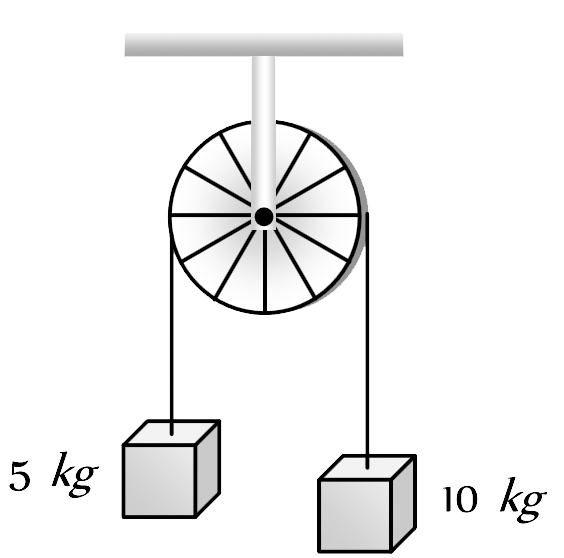Three forces →F1=(3ˆi+2ˆj−ˆk) dynes, →F2=(3ˆi+4ˆj−5ˆk) dynes and →F3=a(ˆi+ˆj−ˆk) dynes act simultaneously on a particle. What should be the value of 'a' so that the particle may remain in equilibrium?Solution in Gujrati
For equilibrium →F1+→F2+→F3=→0⇒3ˆi+2ˆj−ˆk+3ˆi+4ˆj−5ˆk+aˆi+aˆj−aˆk=→0
⇒(6+)aˆi+(6+a)ˆj−(6+a)ˆk=→0⇒(6+a)(ˆi+ˆj−ˆk)=→0
As the vector ˆi+ˆj−ˆk cannot be equal to zero so 6+a=0⇒a=−6
Topper's Solved these Questions
- BOOK - ALLEN CHAPTER - NEWTONS LAWS OF MOTIONEXERCISE - EXERCISE-I52videos
NEWTONS LAWS OF MOTION
- BOOK - ALLEN CHAPTER - NEWTONS LAWS OF MOTIONEXERCISE - EXERCISE-II112videos
NEWTONS LAWS OF MOTION
- BOOK - ALLEN CHAPTER - NEWTONS LAWS OF MOTIONEXERCISE - EXERCISE-III28videos
NEWTONS LAWS OF MOTION
- BOOK - ALLEN CHAPTER - NEWTON'S LAWS OF MOTION & FRICTIONEXERCISE - EXERCISE (JA)4videos
NEWTON'S LAWS OF MOTION & FRICTION
- BOOK - ALLEN CHAPTER - RACEEXERCISE - Basic Maths (Wave Motion & Dopplers Effect) (Stationary waves & doppler effect, beats)25videos
RACE
Similar Questions
USS 150) Two masses of 5 kg and 10 kg are connected to a pulley as shown. What will be the acceleration of the system (g= acceleration due to gravity)
 02:42View Solution
02:42View SolutionA particle is in straight line motion with uniform velocity A force is not required
02:46View SolutionAssertion: The driver in a vechicle moving with a constant speed on a straight road is in a non-inertial frame of referance.
Reason: A reference frame in which Newton's laws of motion are applicable is non-inertial.01:45View SolutionA piece of wire is bent in the shape of a parabola y=kx2 (y-axis vertical) with a bead of mass m on it. The bead can slide on the wire without friction. It stays at the lowest point of the parabola when the wire is at rest. The wire is now accelerated parallel to the x-axis with a constant acceleration a. The distance of the new equilibrium position of the bead, where the bead can stay at rest with respect to the wire, from the y-axis is:
02:56View SolutionThe frequency of a radar is 780 MHz. After getting reflected from an approaching aeroplane, the apparent frequency is more than the actual frequency by 2.6 kHz. The aeroplane has a speed of
02:00View SolutionThree forces →F1,→F2 and →F3 are simultaneously acting on a particle of mass 'm' and keep it in equlibrium. If →F1 force is reversed in direction only, the acceleration of the particle will be.
View SolutionThree forces →F1=a(ˆi−ˆj+ˆk),→F2=2ˆi−3ˆj+4ˆk and →F3=8ˆi−7ˆj+6ˆk act simultaneously on a particle. If the particle is in equilibrium, the value of α is
04:04View SolutionThree force F_(1) = (3hati + 2hatj - hatk) vecF_(2) and that the particle may be in equilibrum , the value of 'a' is :
07:55View SolutionA particle acted upon by constant forces 4ˆi+ˆj−4ˆk and 3ˆi+ˆj−ˆk is displacment from the point ˆi+2ˆj+ˆk to point 5ˆi+4ˆj+ˆk.Total work done by the forces in SI unit is :
01:52View Solutionλ के किस मान के लिए सदिश λˆi−ˆj+ˆk,ˆi+2ˆj−3ˆk तथा 3ˆi−4ˆj+5ˆk समतलीय हैं ?
02:52View SolutionIf particle is acted upon by the forces vecF_(1) = 2hati + 2hatj - 3hatk" "vecF_(2) = 5hati + chatj - bhatk vecF_(3) = bhati + 5hatj - 7hatk, vecF_(4) = chati + 6hatj - ahatk . Find the values of the constant a, b, c in ordre that the particle will be in equilibrium.
View SolutionA particle is acted upon by the forces →F1=2ˆi+aˆj−3ˆk,→F2=5ˆi+cˆj−bˆk,→F3=bˆi+5ˆj−7ˆk,→F4=cˆi+6ˆj−aˆk. Find the values of the constants a, b, c in order that the particle will be in equilibrium.
05:27View SolutionThree forces →F1=(2ˆi+4ˆj)N:→F2=(2ˆj−ˆk)N and →F3=(ˆk−4ˆi−2ˆj)N are applied on an object of mass 1 kg at rest at origin. The position of the object at t = 2s will be
01:45View Solutionसिद्ध कीजिए कि सदिश 2ˆi−ˆj+ˆk,ˆi+2ˆj−3ˆk तथा 3ˆi−4ˆj+5ˆk समतलीय है।
04:21View Solutionनिर्देशांक पद्धति के मूल बिंदु पर विरामावस्था में रखे एक कण पर निम्न बल एक साथ कार्यरत है
→F1=−4ˆi−5ˆj+5ˆk,→F2=5ˆi+8ˆj+6ˆk,→F3=−3ˆi+4ˆj−7ˆk
तथा →F4=2ˆi−3ˆj−2ˆk तो कण गति करेगा।02:00View Solutionएक पिण्ड किन्हीं दो बलों →F1=2ˆi−5ˆj,→F2=3ˆi−4ˆj के अंतर्गत क्रियाशील है। तीसरे बल →F3 के अंतर्गत इसका वेग एकसमान होगा, →F3 है-
06:31View Solution

